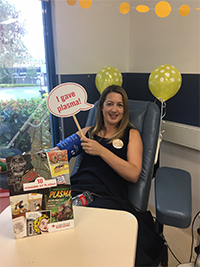Right now the demand for plasma is increasing faster than we’re collecting it — so we’ve launched a new strategy to change that.
Plasma is the most versatile component of human blood; it can be manufactured into numerous life-changing therapeutic products used for the treatment of bleeding disorders, immune system disorders, burns and many other conditions.
Over the past 40 years, the usage and demand for plasma, particularly immunoglobulin (Ig), has risen here and worldwide, and this increase has accelerated in recent years. For example, during the 2014/15 financial year, Australian demand for immunoglobulin increased by 12.4 per cent compared to the previous year.
As recently as 2003-2004, the Blood Service was able to collect enough plasma to completely meet Australian demand, but by 2015/16 only 57 per cent of immunoglobulin given to patients in this country was sourced from Australian donors. This means Australia is increasingly reliant on imports of immunoglobulin from commercial overseas suppliers.
One of the Blood Service’s highest priorities right now is to work towards increasing our capacity to collect more plasma while reducing the cost of doing so. By doing this we hope to mitigate the access risks of relying on an imported supply while providing value for taxpayer money.
To begin this journey, last year we launched a strategic project to identify opportunities to optimise the Australian plasma contribution made by our volunteer, non-remunerated donors. We’ve come up with a series of initiatives to improve the efficiency of how we collect, process and transport plasma and plasma products. Here are some of the exciting and innovative plasma projects we’re working on in the next year.
Plasma donor centre trial
Currently our donor centres are predominantly mixed centres where donors can give whole blood, plasma or platelets. However, a plasma donation is actually quite different to a whole blood donation — not only does it require different equipment, processes and staff training, it takes longer for the donor. There’s also extra demand on donors, as plasma can be donated more often than whole blood: every two weeks as opposed to every 12. Additionally, some donors who aren’t eligible to donate whole blood or platelets can give plasma.
To see how we can more efficiently serve our plasma donors, in the second half of 2017 we’ll be trialling the first dedicated plasma donor centres in Australia. They will have customised, streamlined processes for collecting and processing plasma, supported by new technologies and equipment.
We know from donor feedback that the better the experience people have while donating, the more likely they are to come back and donate again, so these new plasma centres will be custom-designed for plasma donors. We’re investigating new technologies to do this, including making the eligibility assessment process smoother and quicker with a self-serve digital donor questionnaire. During the donation, donors will enjoy a modern lounge-like experience, with potential features like warmed saline for their mid-donation saline infusion and more entertainment options, including personal device docks.
ADOPTing plasma for first-timers
At the moment, all new blood donors must give a successful whole blood donation before they can ‘graduate’ to plasma for their second or later donations.
To potentially change this, the Blood Service is running the First Attendance DOnor Plasma Apheresis STudy (ADOPT) trial in 10 blood donor sites across Australia, where first-time donors aged 30 years or higher are being offered the option to give plasma as their first donation. If ADOPT is successful in proving the practicality, safety, donor experience and efficacy of first-time plasma donation, we plan to roll-out the option nationally by the end of 2017.
Better processes
Along with changing how we interact with and serve plasma donors, we’re also transforming our processing, storage and infrastructure to get plasma from donor to patient more efficiently and quickly. Changes we’re investigating include more processing automation and on-site plasma freezing at donor centres.
*National Blood Authority Annual Report 2015-16.

